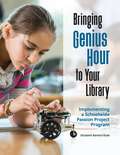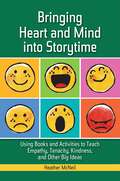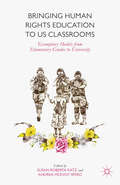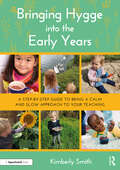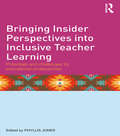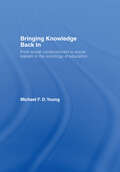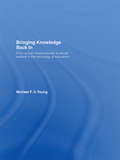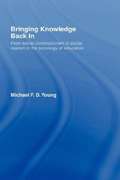- Table View
- List View
Bringing Forth the Bard: A guide to teaching Shakespeare in the English classroom
by Zoe EnserForeword by Professor Emma Smith.The more you explore the plays of Shakespeare, the more you realise how they are an interrelated network of ideas and themes linked to his context, his audience and his understanding of the world. This book aims to equip busy teachers with the core knowledge of Shakespeare's body of work, enabling them to make links between themes, characters, language and allusions.Each section includes tips on how to bring this to life in the classroom, and features case studies from practising teachers in a range of contexts to illustrate how they can ensure that their students develop an appreciation of his work moving beyond the requirements of exams and empowering them to engage in the discussion around his influence and enduring appeal.The link between subject knowledge and pedagogical approaches runs throughout the book, focusing on the Shakespeare plays most popularly taught in the classroom and how we can enrich students' understanding of these by looking both at the links across the domain and the bigger picture his work presents.
Bringing French to Life: Creative activities for 5-11
by Catherine Watts Hilary PhillipsBringing French to Life provides an innovative and refreshing cross-curricular approach to teaching languages in primary schools, combining art, design and foreign languages with various aspects of the National Primary Curriculum such as Literacy, Numeracy and PE. This unique practical resource comprises an engaging storyline about a day in the life of two French children and gives an opportunity for learners to re-enact their day, using finger puppets, handmade crafts and exciting games to practise new language. Each of the 14 sections begins with a short accessible dialogue in French and is followed by suggestions for using the new vocabulary in pairs, small groups or as a whole class. The main story is accompanied by fun craft activities linked to the story (one for each section, ie 14 in total) for children to create in class using the templates and instructions provided. A wide range of further activities follows, consisting of lively games, songs and opportunities to communicate simple ideas. Language extensions are suggested, focussing on imaginative writing and reading ideas linked to the theme of each section. Written to support the new foreign languages programme of study the book also includes: * Cross-curricular links to numerous subjects including Literacy, Numeracy, PE and ICT * Classroom games and activities * Photocopiable resources and templates for fun classroom activities and projects * Language extension activities. Bringing French to Life can be read on three levels to suit a variety of classroom situations. First, the story can be told ‘straight’ with the whole class participating in the dialogues. Second, the story can be combined with the craft activities after each main section. 14 doing and making activities match the storyline and provide a colourful, eye catching display and learning focus in the classroom or for Open Days or Assemblies. Teachers can use as many or as few as they wish. The resultant crafts can be used for very effective classroom displays/open days/assemblies etc. Finally, the language extension activities can be used alongside the art/craft/design activities as desired. The aim of these activities is to extend the target language in a relevant context through a variety of methods such as songs, playlets, simple communicative exchanges, games with numbers etc.
Bringing French to Life: Creative activities for 5-11
by Catherine Watts Hilary PhillipsBringing French to Life provides an innovative and refreshing cross-curricular approach to teaching languages in primary schools, combining art, design and foreign languages with various aspects of the National Primary Curriculum such as Literacy, Numeracy and PE. This unique practical resource comprises an engaging storyline about a day in the life of two French children and gives an opportunity for learners to re-enact their day, using finger puppets, handmade crafts and exciting games to practise new language. Each of the 14 sections begins with a short accessible dialogue in French and is followed by suggestions for using the new vocabulary in pairs, small groups or as a whole class. The main story is accompanied by fun craft activities linked to the story (one for each section, ie 14 in total) for children to create in class using the templates and instructions provided. A wide range of further activities follows, consisting of lively games, songs and opportunities to communicate simple ideas. Language extensions are suggested, focussing on imaginative writing and reading ideas linked to the theme of each section. Written to support the new foreign languages programme of study the book also includes: * Cross-curricular links to numerous subjects including Literacy, Numeracy, PE and ICT * Classroom games and activities * Photocopiable resources and templates for fun classroom activities and projects * Language extension activities. Bringing French to Life can be read on three levels to suit a variety of classroom situations. First, the story can be told ‘straight’ with the whole class participating in the dialogues. Second, the story can be combined with the craft activities after each main section. 14 doing and making activities match the storyline and provide a colourful, eye catching display and learning focus in the classroom or for Open Days or Assemblies. Teachers can use as many or as few as they wish. The resultant crafts can be used for very effective classroom displays/open days/assemblies etc. Finally, the language extension activities can be used alongside the art/craft/design activities as desired. The aim of these activities is to extend the target language in a relevant context through a variety of methods such as songs, playlets, simple communicative exchanges, games with numbers etc.
Bringing Genius Hour to Your Library: Implementing a Schoolwide Passion Project Program
by Elizabeth Barrera RushThis unique book presents a practical and realistic approach to implementing a school-wide, K–12 Genius Hour program—one that can succeed regardless of budgetary and infrastructure constraints.Genius Hour is a movement in which students are allowed to spend a portion of their in-school time learning about a topic of their choosing—even subjects outside of the curriculum. When properly implemented, a Genius Hour program can create true passion for learning among unmotivated students, ignite interest in STEM as well as the arts, encourage collaboration, improve the relationship between educator and students, and help prepare students for real life outside of the educational system. But revamping a school library program to offer a Genius Hour program may seem like an insurmountable task—especially when working with a limited staff or budget.This book provides specific direction and concrete advice that enables school librarians to lead a school-wide program for all grade levels, from kindergarten to 12th grade. It explains why Genius Hour is the perfect program complement to the learning commons environment; presents research and support that will empower librarians to make a convincing case to administration; explains how to enlist the participation of faculty; and provides step-by-step guidance to begin, successfully manage, and grow a campus-wide Genius Hour. Librarians will see why investing in "creative teaching" is worth the effort, despite their limited time and resources; understand how to help underperforming students make their distractions "count" in school; and look forward to playing a part in creating imaginative and independent thinkers, not test takers.
Bringing Genius Hour to Your Library: Implementing a Schoolwide Passion Project Program
by Elizabeth Barrera RushThis unique book presents a practical and realistic approach to implementing a school-wide, K–12 Genius Hour program—one that can succeed regardless of budgetary and infrastructure constraints.Genius Hour is a movement in which students are allowed to spend a portion of their in-school time learning about a topic of their choosing—even subjects outside of the curriculum. When properly implemented, a Genius Hour program can create true passion for learning among unmotivated students, ignite interest in STEM as well as the arts, encourage collaboration, improve the relationship between educator and students, and help prepare students for real life outside of the educational system. But revamping a school library program to offer a Genius Hour program may seem like an insurmountable task—especially when working with a limited staff or budget.This book provides specific direction and concrete advice that enables school librarians to lead a school-wide program for all grade levels, from kindergarten to 12th grade. It explains why Genius Hour is the perfect program complement to the learning commons environment; presents research and support that will empower librarians to make a convincing case to administration; explains how to enlist the participation of faculty; and provides step-by-step guidance to begin, successfully manage, and grow a campus-wide Genius Hour. Librarians will see why investing in "creative teaching" is worth the effort, despite their limited time and resources; understand how to help underperforming students make their distractions "count" in school; and look forward to playing a part in creating imaginative and independent thinkers, not test takers.
Bringing German to Life: Creative activities for 5-11
by Catherine Watts Hilary PhillipsBringing German to Life provides an innovative and refreshing cross-curricular approach to teaching languages in primary schools, combining art, design and foreign languages with various aspects of the National Primary Curriculum such as Literacy, Numeracy and PE. This unique practical resource comprises an engaging storyline about a day in the life of two German children and gives an opportunity for learners to re-enact their day, using finger puppets, handmade crafts and exciting games to practise new language. Each of the 14 sections begins with a short accessible dialogue in German and is followed by suggestions for using the new vocabulary in pairs, small groups or as a whole class. The main story is accompanied by fun craft activities linked to the story (one for each section, ie 14 in total) for children to create in class using the templates and instructions provided. A wide range of further activities follows, consisting of lively games, songs and opportunities to communicate simple ideas. Language extensions are suggested, focussing on imaginative writing and reading ideas linked to the theme of each section. Written to support the new foreign languages programme of study, the book also includes: * Cross-curricular links to numerous subjects including Literacy, Numeracy, PE and ICT * Classroom games and activities * Photocopiable resources and templates for fun classroom activities and projects * Language extension activities. Bringing German to Life can be read on three levels to suit a variety of classroom situations. First, the story can be told ‘straight’ with the whole class participating in the dialogues. Second, the story can be combined with the craft activities after each main section. 14 doing and making activities match the storyline and provide a colourful, eye-catching display and learning focus in the classroom or for Open Days or Assemblies. Teachers can use as many or as few as they wish. The resultant crafts can be used for very effective classroom displays/open days/assemblies etc. Finally, the language extension activities can be used alongside the art/craft/design activities as desired. The aim of these activities is to extend the target language in a relevant context through a variety of methods such as songs, playlets, simple communicative exchanges, games with numbers etc.
Bringing German to Life: Creative activities for 5-11
by Catherine Watts Hilary PhillipsBringing German to Life provides an innovative and refreshing cross-curricular approach to teaching languages in primary schools, combining art, design and foreign languages with various aspects of the National Primary Curriculum such as Literacy, Numeracy and PE. This unique practical resource comprises an engaging storyline about a day in the life of two German children and gives an opportunity for learners to re-enact their day, using finger puppets, handmade crafts and exciting games to practise new language. Each of the 14 sections begins with a short accessible dialogue in German and is followed by suggestions for using the new vocabulary in pairs, small groups or as a whole class. The main story is accompanied by fun craft activities linked to the story (one for each section, ie 14 in total) for children to create in class using the templates and instructions provided. A wide range of further activities follows, consisting of lively games, songs and opportunities to communicate simple ideas. Language extensions are suggested, focussing on imaginative writing and reading ideas linked to the theme of each section. Written to support the new foreign languages programme of study, the book also includes: * Cross-curricular links to numerous subjects including Literacy, Numeracy, PE and ICT * Classroom games and activities * Photocopiable resources and templates for fun classroom activities and projects * Language extension activities. Bringing German to Life can be read on three levels to suit a variety of classroom situations. First, the story can be told ‘straight’ with the whole class participating in the dialogues. Second, the story can be combined with the craft activities after each main section. 14 doing and making activities match the storyline and provide a colourful, eye-catching display and learning focus in the classroom or for Open Days or Assemblies. Teachers can use as many or as few as they wish. The resultant crafts can be used for very effective classroom displays/open days/assemblies etc. Finally, the language extension activities can be used alongside the art/craft/design activities as desired. The aim of these activities is to extend the target language in a relevant context through a variety of methods such as songs, playlets, simple communicative exchanges, games with numbers etc.
Bringing Heart and Mind into Storytime: Using Books and Activities to Teach Empathy, Tenacity, Kindness, and Other Big Ideas
by Heather McNeilLearn how to use children's books during storytime to approach sensitive topics and increase children's social-emotional wellness-and how to create storytimes that are engaging, participative, and FUN!The emotional challenges many children experience consume the time of teachers, exhaust parents, and sometimes lead children toward behaviors that prohibit social and academic success. Storytime to the rescue! Library storytimes prepare children for kindergarten; storytimes at home and in preschools allow teachers, parents, and children to think and talk about empathy and the importance of honoring your own and others' feelings.In Bringing Heart and Mind into Storytime, Heather McNeil teaches librarians and teachers how to use books to open conversations with children to teach such concepts as patience, tenacity, kindness, and teamwork. McNeil shares research on brain development, social-emotional learning, and the importance of play, but she also emphasizes maintaining the fun of storytime. She recommends songs, action rhymes, games, and crafts that contribute to fun and healthy storytimes. Extensive lists of recommended books will help readers find the right ones for their audience.
Bringing Heart and Mind into Storytime: Using Books and Activities to Teach Empathy, Tenacity, Kindness, and Other Big Ideas
by Heather McNeilLearn how to use children's books during storytime to approach sensitive topics and increase children's social-emotional wellness-and how to create storytimes that are engaging, participative, and FUN!The emotional challenges many children experience consume the time of teachers, exhaust parents, and sometimes lead children toward behaviors that prohibit social and academic success. Storytime to the rescue! Library storytimes prepare children for kindergarten; storytimes at home and in preschools allow teachers, parents, and children to think and talk about empathy and the importance of honoring your own and others' feelings.In Bringing Heart and Mind into Storytime, Heather McNeil teaches librarians and teachers how to use books to open conversations with children to teach such concepts as patience, tenacity, kindness, and teamwork. McNeil shares research on brain development, social-emotional learning, and the importance of play, but she also emphasizes maintaining the fun of storytime. She recommends songs, action rhymes, games, and crafts that contribute to fun and healthy storytimes. Extensive lists of recommended books will help readers find the right ones for their audience.
Bringing History Alive through Local People and Places: A guide for primary school teachers
by Lynne Dixon Alison HalesA much-needed and delightful book. It shows how history can be taught with the meaningful experiences of each child at its centre, making connections between the child, the locality and community, the national and global past and concepts of time. Throughout the authors empower teachers to adopt their philosophy, by showing them how to plan, select resources and strategies and reflect on ideas and case studies. Hilary Cooper, Emeritus professor of history and pedagogy, The University of Cumbria, UK. Bringing History Alive through Local People and Places puts the local environment and community at the heart of history, showing how it can be used as the context for successful history teaching across the primary age range. It considers how to develop children’s concepts and skills through local history, how to link local, national and global aspects of history, and helps you develop your own historical knowledge, understanding and confidence in teaching the subject. Practical topics explored include: Investigating children’s cultural and geographical roots through fieldwork Finding and visiting local museums, archives and heritage sights Choosing and using resources Using significant people, events and buildings to link with national history Environmental education and sustainable development through local history Understanding the links between history and everyday life Planning and assessing history. Based on the latest research and practice in the field, Bringing History Alive through Local People and Places offers an exciting template of creative ideas and activities to show teachers how they can make history relevant to all children.
Bringing History Alive through Local People and Places: A guide for primary school teachers
by Lynne Dixon Alison HalesA much-needed and delightful book. It shows how history can be taught with the meaningful experiences of each child at its centre, making connections between the child, the locality and community, the national and global past and concepts of time. Throughout the authors empower teachers to adopt their philosophy, by showing them how to plan, select resources and strategies and reflect on ideas and case studies. Hilary Cooper, Emeritus professor of history and pedagogy, The University of Cumbria, UK. Bringing History Alive through Local People and Places puts the local environment and community at the heart of history, showing how it can be used as the context for successful history teaching across the primary age range. It considers how to develop children’s concepts and skills through local history, how to link local, national and global aspects of history, and helps you develop your own historical knowledge, understanding and confidence in teaching the subject. Practical topics explored include: Investigating children’s cultural and geographical roots through fieldwork Finding and visiting local museums, archives and heritage sights Choosing and using resources Using significant people, events and buildings to link with national history Environmental education and sustainable development through local history Understanding the links between history and everyday life Planning and assessing history. Based on the latest research and practice in the field, Bringing History Alive through Local People and Places offers an exciting template of creative ideas and activities to show teachers how they can make history relevant to all children.
Bringing Human Rights Education to US Classrooms: Exemplary Models from Elementary Grades to University
by Andrea McEvoy SperoThis book offers research-based models of exemplary practice for educators at all grade levels, from primary school to university, who want to integrate human rights education into their classrooms. It includes ten examples of projects that have been effectively implemented in classrooms: two from elementary school, two from middle school, three from high school, two from community college, and one from a university. Each model discusses the scope of the project, its rationale, students' response to the content and pedagogy, challenges or controversies that arose, and their resolution. Unique in integrating theory and practice and in addressing human rights issues with special relevance for communities of color in the US, this book provides indispensable guidance for those studying and teaching human rights.
Bringing Hygge into the Early Years: A Step-by-Step Guide to Bring a Calm and Slow Approach to Your Teaching
by Kimberly SmithBringing Hygge into the Early Years is a “how-to” guide for every early educator who wishes to bring more calmness and balance into their day, in turn, leaving them feeling empowered to teach and live well. Drawing from the author’s experience of embracing the Scandinavian way of living well, “hygge,” this book explores how this approach can have a positive impact across your early years setting, from improved mental health and wellbeing, to embracing child-led play and high-quality outdoor provision. With step-by-step guidance on how to embed the approach alongside examples of hygge from early educators around the world, the book is divided into four main parts: Re-balance you The hygge environment Slow teaching Embracing nature Throughout each chapter, case studies and activities provide the opportunity to reflect on existing practice and support you as you make positive changes to both your wellbeing and provision. This guide will be essential reading for all early years professionals, offering further support to improve mental health and wellbeing, as well as valuable tools to lead early years practice with confidence and joy.
Bringing Hygge into the Early Years: A Step-by-Step Guide to Bring a Calm and Slow Approach to Your Teaching
by Kimberly SmithBringing Hygge into the Early Years is a “how-to” guide for every early educator who wishes to bring more calmness and balance into their day, in turn, leaving them feeling empowered to teach and live well. Drawing from the author’s experience of embracing the Scandinavian way of living well, “hygge,” this book explores how this approach can have a positive impact across your early years setting, from improved mental health and wellbeing, to embracing child-led play and high-quality outdoor provision. With step-by-step guidance on how to embed the approach alongside examples of hygge from early educators around the world, the book is divided into four main parts: Re-balance you The hygge environment Slow teaching Embracing nature Throughout each chapter, case studies and activities provide the opportunity to reflect on existing practice and support you as you make positive changes to both your wellbeing and provision. This guide will be essential reading for all early years professionals, offering further support to improve mental health and wellbeing, as well as valuable tools to lead early years practice with confidence and joy.
Bringing Innovative Practices to Your School: Lessons from International Schools
by Jayson W. RichardsonExploring issues of student agency, equity, assessment, teaching, management, teacher leadership, and use of technology, this book provides strategies, tips, and guidance for enacting innovative change in today‘s schools. Drawing from unique and creative approaches at international schools, real practitioners share their stories and best-practices. Chapters contain engaging snapshots of the innovative practices currently happening in international schools, translate those practices into leadership actions, and show how those innovations are played out in localized contexts. This exciting book is for every school and district leader keen to think outside the box, reassess their schools’ strengths, and improve the purposes and means by which they educate students.
Bringing Innovative Practices to Your School: Lessons from International Schools
by Jayson W. RichardsonExploring issues of student agency, equity, assessment, teaching, management, teacher leadership, and use of technology, this book provides strategies, tips, and guidance for enacting innovative change in today‘s schools. Drawing from unique and creative approaches at international schools, real practitioners share their stories and best-practices. Chapters contain engaging snapshots of the innovative practices currently happening in international schools, translate those practices into leadership actions, and show how those innovations are played out in localized contexts. This exciting book is for every school and district leader keen to think outside the box, reassess their schools’ strengths, and improve the purposes and means by which they educate students.
Bringing Insider Perspectives into Inclusive Teacher Learning: Potentials and challenges for educational professionals
by Phyllis JonesThis fascinating text offers a compelling argument for the need to include insider perspectives of disability in teacher education programs, in order to enrich professional understandings and shed light on the reality of living with a disability. With contributions from a highly experienced team of authors from a wide range of educational settings, Bringing Insider Perspectives into Inclusive Teacher Learning includes case studies and research projects on how teacher educators gather, interpret and integrate insider perspectives into teacher education programs, along with practical strategies as to how educators can develop programs more sensitive to the experiences of ‘insiders’. Questions addressed include: How do teacher educator researchers gather insider perspectives? What are some of the barriers and challenges involved? What critical experiences and lessons can be learned from teacher educators who have integrated insider perspectives? How can insider perspectives bring about a more meaningful inclusion of students with disabilities? Offering a range of different methodologies to engage students, parents, teachers, school leaders and teacher educators, this thought-provoking book provides practical ideas about how insider perspectives can enhance teacher learning and support greater inclusive practices in schools. This text will be useful to university lecturers, teachers and education specialists, as well as students of educational studies and ITE courses from foundation degree level through to undergraduate and postgraduate study.
Bringing Insider Perspectives into Inclusive Teacher Learning: Potentials and challenges for educational professionals
by Phyllis JonesThis fascinating text offers a compelling argument for the need to include insider perspectives of disability in teacher education programs, in order to enrich professional understandings and shed light on the reality of living with a disability. With contributions from a highly experienced team of authors from a wide range of educational settings, Bringing Insider Perspectives into Inclusive Teacher Learning includes case studies and research projects on how teacher educators gather, interpret and integrate insider perspectives into teacher education programs, along with practical strategies as to how educators can develop programs more sensitive to the experiences of ‘insiders’. Questions addressed include: How do teacher educator researchers gather insider perspectives? What are some of the barriers and challenges involved? What critical experiences and lessons can be learned from teacher educators who have integrated insider perspectives? How can insider perspectives bring about a more meaningful inclusion of students with disabilities? Offering a range of different methodologies to engage students, parents, teachers, school leaders and teacher educators, this thought-provoking book provides practical ideas about how insider perspectives can enhance teacher learning and support greater inclusive practices in schools. This text will be useful to university lecturers, teachers and education specialists, as well as students of educational studies and ITE courses from foundation degree level through to undergraduate and postgraduate study.
Bringing Knowledge Back In: From Social Constructivism to Social Realism in the Sociology of Education
by Michael Young'This book tackles some of the most important educational questions of the day... It is rare to find a book on education which is theoretically sophisticated and practically relevant: this book is.' From the Foreword by Hugh Lauder What is it in the twenty-first century that we want young people, and adults returning to study, to know? What is it about the kind of knowledge that people can acquire at school, college or university that distinguishes it from the knowledge that people acquire in their everyday lives everyday lives, at work, and in their families? Bringing Knowledge Back In draws on recent developments in the sociology of knowledge to propose answers to these key, but often overlooked, educational questions. Michael Young traces the changes in his own thinking about the question of knowledge in education since his earlier books Knowledge and Control and The Curriculum of the Future. He argues for the continuing relevance of the writings of Durkheim and Vygotsky and the unique importance of Basil Bernstein’s often under-appreciated work. He illustrates the importance of questions about knowledge by investigating the dilemmas faced by researchers and policy makers in a range of fields. He also considers the broader issue of the role of sociologists in relation to educational policy in the context of increasingly interventionist governments. In so doing, the book: provides conceptual tools for people to think and debate about knowledge and education in new ways provides clear expositions of difficult ideas at the interface of epistemology and the sociology of knowledge makes explicit links between theoretical issues and practical /policy questions offers a clear focus for the future development of the sociology of education as a key field within educational studies. This compelling and provocative book will be essential reading for anyone involved in research and debates about the curriculum as well as those with a specific interest in the sociology of education.
Bringing Knowledge Back In: From Social Constructivism to Social Realism in the Sociology of Education
by Michael Young'This book tackles some of the most important educational questions of the day... It is rare to find a book on education which is theoretically sophisticated and practically relevant: this book is.' From the Foreword by Hugh Lauder What is it in the twenty-first century that we want young people, and adults returning to study, to know? What is it about the kind of knowledge that people can acquire at school, college or university that distinguishes it from the knowledge that people acquire in their everyday lives everyday lives, at work, and in their families? Bringing Knowledge Back In draws on recent developments in the sociology of knowledge to propose answers to these key, but often overlooked, educational questions. Michael Young traces the changes in his own thinking about the question of knowledge in education since his earlier books Knowledge and Control and The Curriculum of the Future. He argues for the continuing relevance of the writings of Durkheim and Vygotsky and the unique importance of Basil Bernstein’s often under-appreciated work. He illustrates the importance of questions about knowledge by investigating the dilemmas faced by researchers and policy makers in a range of fields. He also considers the broader issue of the role of sociologists in relation to educational policy in the context of increasingly interventionist governments. In so doing, the book: provides conceptual tools for people to think and debate about knowledge and education in new ways provides clear expositions of difficult ideas at the interface of epistemology and the sociology of knowledge makes explicit links between theoretical issues and practical /policy questions offers a clear focus for the future development of the sociology of education as a key field within educational studies. This compelling and provocative book will be essential reading for anyone involved in research and debates about the curriculum as well as those with a specific interest in the sociology of education.
Bringing Knowledge Back In: From Social Constructivism to Social Realism in the Sociology of Education
by Michael F. D. Young'This book tackles some of the most important educational questions of the day. . . It is rare to find a book on education which is theoretically sophisticated and practically relevant: this book is. ' From the Foreword by Hugh Lauder What is it in the twenty-first century that we want young people, and adults returning to study, to know? What is it about the kind of knowledge that people can acquire at school, college or university that distinguishes it from the knowledge that people acquire in their everyday lives everyday lives, at work, and in their families? Bringing Knowledge Back Indraws on recent developments in the sociology of knowledge to propose answers to these key, but often overlooked, educational questions. Michael Young traces the changes in his own thinking about the question of knowledge in education since his earlier books Knowledge and Control and The Curriculum of the Future. He argues for the continuing relevance of the writings of Durkheim and Vygotsky and the unique importance of Basil Bernstein's often under-appreciated work. He illustrates the importance of questions about knowledge by investigating the dilemmas faced by researchers and policy makers in a range of fields. He also considers the broader issue of the role of sociologists in relation to educational policy in the context of increasingly interventionist governments. In so doing, the book: provides conceptual tools for people to think and debate about knowledge and education in new ways provides clear expositions of difficult ideas at the interface of epistemology and the sociology of knowledge makes explicit links between theoretical issues and practical /policy questions offers a clear focus for the future development of the sociology of education as a key field within educational studies. This compelling and provocative book will be essential reading for anyone involved in research and debates about the curriculum as well as those with a specific interest in the sociology of education. 9780415321211 9780203073667
Bringing Knowledge Back In: From Social Constructivism to Social Realism in the Sociology of Education (PDF)
by Michael F. D. Young'This book tackles some of the most important educational questions of the day. . . It is rare to find a book on education which is theoretically sophisticated and practically relevant: this book is. ' From the Foreword by Hugh Lauder What is it in the twenty-first century that we want young people, and adults returning to study, to know? What is it about the kind of knowledge that people can acquire at school, college or university that distinguishes it from the knowledge that people acquire in their everyday lives everyday lives, at work, and in their families? Bringing Knowledge Back Indraws on recent developments in the sociology of knowledge to propose answers to these key, but often overlooked, educational questions. Michael Young traces the changes in his own thinking about the question of knowledge in education since his earlier books Knowledge and Control and The Curriculum of the Future. He argues for the continuing relevance of the writings of Durkheim and Vygotsky and the unique importance of Basil Bernstein's often under-appreciated work. He illustrates the importance of questions about knowledge by investigating the dilemmas faced by researchers and policy makers in a range of fields. He also considers the broader issue of the role of sociologists in relation to educational policy in the context of increasingly interventionist governments. In so doing, the book: provides conceptual tools for people to think and debate about knowledge and education in new ways provides clear expositions of difficult ideas at the interface of epistemology and the sociology of knowledge makes explicit links between theoretical issues and practical /policy questions offers a clear focus for the future development of the sociology of education as a key field within educational studies. This compelling and provocative book will be essential reading for anyone involved in research and debates about the curriculum as well as those with a specific interest in the sociology of education. 9780415321211 9780203073667
Bringing Leadership to Life in Health: A New Perspective
by Graham Dickson Bill ThollGlobally, the health sector faces significant demands for reform and improvement to meet the needs of the 21st Century. To achieve that goal, highly sophisticated and capable leaders are required across all dimensions of the health system. This book describes the key challenges that demand reform, why better leadership is the source code for better system performance, and the issues that stand in the way of getting that leadership. It includes substantive treatment of the modern democratic challenges that healthcare leaders face; and the essence of what it means to be a leader in today’s world. The essence of leadership itself is described, and the case made for the need for people to use the workplace as the place to develop leadership rather than relying solely on formal programs. It will also outline a self-directed learning process that any individual leader—citizen, clinician, or senior executive—can use to develop their own leadership capability, and thus become more active as a leader of change. This book addresses the need for leaders to think on a system-wide scale. A second part of the book focuses primarily on the Canadian Health system and LEADS in a Caring Environment capabilities framework, and the link between LEADS and frameworks in Australia and the UK. LEADS was developed through a partnership between members of the Healthcare Leaders Association of British Columbia and the Canadian College of Health Leaders, the Canadian Health Leadership Network and Royal Roads University. Currently it is stewarded by a not-for-profit collaboration that has endorsed LEADS as an evidence-informed set of national expectations for Canadian health leaders. LEADS has been endorsed by many health organizations in almost all provinces in Canada as a foundation for their talent management programs in leadership (development and succession planning). The book will address the research foundations for the LEADS framework; how it was developed; the framework’s contents; its congruence with other national frameworks, and how LEADS can be used as a model to envisage and plan change.
Bringing Leadership to Life in Health: Putting LEADS to work
by Graham Dickson Bill ThollThis edited volume, featuring five new chapters from invited authors, provides an updated and evidence-based explanation of leadership within a healthcare environment. The book discusses new insights garnered from recent research into the importance of leadership in health system redesign and highlights the practice of shared or distributed health care leadership. New chapters covering LEADS in a national, regional, Indigenous, health profession, and people-centred care context provide new insights into how LEADS is being put to work to transform health systems. The LEADS framework has been refreshed in relation to each of its different elements and tools, with an emphasis on providing real-life examples of how LEADS has been put to work. LEADS is also explained as a change leadership model and in relation to how it helps to level the playing field in terms of gender and diversity in health leadership. The book aims to inform the leadership needs of health reform and its emergent system wide challenges. The content is relevant to health care administrators and professionals working within the public service, academic institutions, and health care delivery organisations.
Bringing Out the Algebraic Character of Arithmetic: From Children's Ideas To Classroom Practice
by Analucia D. SchliemannBringing Out the Algebraic Character of Arithmetic contributes to a growing body of research relevant to efforts to make algebra an integral part of early mathematics instruction, an area of studies that has come to be known as Early Algebra. It provides both a rationale for promoting algebraic reasoning in the elementary school curriculum and empi


